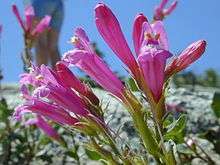Penstemon
| Penstemon | |
|---|---|
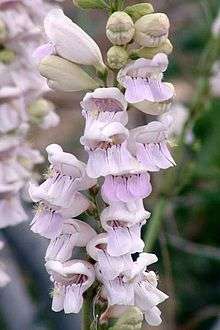 | |
| balloon flower (Penstemon palmeri) | |
| Scientific classification | |
| Kingdom: | Plantae |
| (unranked): | Angiosperms |
| (unranked): | Eudicots |
| (unranked): | Asterids |
| Order: | Lamiales |
| Family: | Plantaginaceae |
| Genus: | Penstemon Schmidel, 1763 |
| Species | |
|
See text. | |
Penstemon /ˈpɛnstᵻmən/,[1] the beardtongues, is a large genus of roughly 250 species North American and East Asian flowering plants. Formerly placed in the Scrophulariaceae family by the Cronquist system, new genetic research has placed it in the vastly expanded Plantaginaceae family.
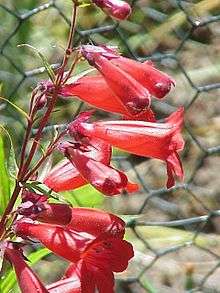
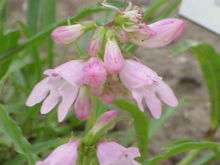
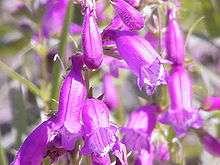





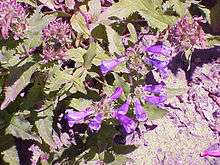
0.jpg)



They have opposite leaves, partly tube-shaped, and two-lipped flowers and seed capsules. The most distinctive feature of the genus is the prominent staminode, an infertile stamen. The staminode takes a variety of forms in the different species; while typically a long straight filament extending to the mouth of the corolla, some are longer and extremely hairy, giving the general appearance of an open mouth with a fuzzy tongue protruding and inspiring the common name beardtongue.
Most penstemons are deciduous or semi-evergreen perennials, the remainder being shrubs or subshrubs. Heights can range from 10 cm to as much as 3 metres.
The one Asiatic species previously treated in Penstemon is now placed in a separate genus Pennellianthus. This leaves Penstemon a mostly nearctic genus, with a few neotropical species. Although widespread across North America, and found in habitats ranging from open desert to moist forests, and up to the alpine zone, they are not typically common within their range.
History
John Mitchell published the first scientific description in 1748; although he only named it as Penstemon, we can identify it as P. laevigatus. Linnaeus then included it in his 1753 publication, as Chelone pentstemon, altering the spelling to better correspond to the notion that the name referred to the unusual fifth stamen (Greek "penta-", five). Mitchell's work was reprinted in 1769, continuing with his original spelling, and this was ultimately accepted as the official form, although Pentstemon continued in use into the 20th century.
Although several more species were found in the 18th century, they continued to be classified in Chelone until about the 1820s. The period of 1810 to 1850 increased the number of known species from 4 to 63, as expeditions traveled through Mexico and the western United States, followed by another 100 up to 1900.
During this time, seeds began to be offered for sale in Europe, the earliest known dating from 1813, with John Fraser offering four species in London, followed by Flanagan & Nutting offering nine species in their 1835 catalog. Subsequently many hybrids were developed in Europe.
Fieldwork in the remote parts of the Great Basin during the 20th century brought the total number of species known to over 250. The genus was extensively revised by David Keck between 1932 and 1957; in 1946 the American Penstemon Society was formed to promote both horticultural and botanical interest.
Uses
Some Native American tribes used penstemons as medicinal remedies for humans and animals.[2] Today its primary use is ornamental.
Horticulture
Although penstemons are among the most attractive native flowers of North America, Europe has traditionally been far more active in their hybridization with hundreds of hybrids developed since the early 19th century. The earliest development is somewhat shrouded in mystery; for instance Flanagan & Nutting's 1835 catalog mentions a 'Penstemon Hybridum' but does not describe it.
By 1860, a half-dozen French growers are known to have developed hybrids, most notably Victor Lemoine, while in 1857 the German Wilhelm Pfitzer listed 24 varieties. In 1861 the Royal Horticultural Society held trials in which 78 varieties were entered. The Scottish firm of John Forbes first offered penstemons in 1870, eventually becoming the biggest grower in the world; in 1884 their catalog listed 180 varieties. By 1900 Forbes had offered 550 varieties, while Lemoine had developed nearly 470 by the time of his death in 1911. Few of these have survived to the present day.
A number of different species have been used in the hybridization process, notably P. cobaeus and P. hartwegii.
In North America, penstemons are often used in xeriscape landscaping, as many are native to desert or alpine regions and thus quite hardy. One of the largest collections of penstemons in North America is found at The Arboretum at Flagstaff, Arizona, which hosts a Penstemon Festival each summer.[3]
The following cultivars have gained the Royal Horticultural Society's Award of Garden Merit:-
| 'Alice Hindley'[4] | P. isophyllus[5] | |
| 'Andenken an Friedrich Hahn'[6] | 'Margery Fish'[7] | |
| 'Apple Blossom'[8] | 'Maurice Gibbs'[9] | |
| 'Beech Park'[10] | 'Osprey'[11] | |
| 'Cherry'[12] | 'Pennington Gem'[13] | |
| 'Chester Scarlet'[14] | 'Port Wine'[15] | |
| 'Connie's Pink'[16] | 'Roy Davidson'[17] | |
| 'Evelyn'[18] | 'Raven'[19] | |
| 'George Home'[20] | 'Rubicundus'[21] | |
| P. hartwegii[22] | 'Schoenholzeri'[23] | |
| 'Catherine de la Mare'[24] | 'Sour Grapes'[25] | |
| 'Hewell Pink Bedder'[26] | 'Stapleford Gem'[27] | |
| 'Hidcote Pink'[28] | 'White Bedder'[29] |
Others include 'Dark Towers', developed by Dale Lindgren at the University of Nebraska. [30]
Species
- Penstemon abietinus Pennell – Firleaf beardtongue
- Penstemon absarokensis Evert – Absaroka Range beardtongue
- Penstemon acaulis L.O. Williams – Stemless beardtongue
- Penstemon acuminatus Dougl. ex Lindl. – Sharpleaf penstemon
- Penstemon alamosensis Pennell & Nisbet – Los Alamos beardtongue
- Penstemon albertinus Greene – Alberta beardtongue
- Penstemon albidus Nutt. – White penstemon
- Penstemon albomarginalis M. E. Jones
- Penstemon albomarginatus M.E. Jones – White margin penstemon, whitemargin beardtongue, whitemargin penstemon
- Penstemon alluviorum Pennell – lowland beardtongue
- Penstemon ambiguus Torr. – bush penstemon, gilia beardtongue, gilia penstemon
- Penstemon ammophilus N. Holmgren & L. Shultz – sandloving penstemon
- Penstemon anguineus Eastw. – Siskiyou beardtongue
- Penstemon angustifolius Nutt. ex Pursh – broad-beard beardtongue, broadbeard beardtongue, narrowleaf penstemon
- Penstemon arenarius Greene – Nevada sanddune beardtongue, sanddune penstemon
- Penstemon arenicola A. Nels. – sand penstemon
- Penstemon aridus Rydb. – stiffleaf penstemon
- Penstemon arkansanus Pennell – Arkansas beardtongue
- Penstemon attenuatus Dougl. ex Lindl. – sulphur penstemon
- Penstemon atwoodii Welsh – Kaiparowits beardtongue
- Penstemon auriberbis Pennell – Colorado beardtongue
- Penstemon australis Small – Eustis Lake beardtongue
- Penstemon azureus Benth. – azure penstemon
- Penstemon baccharifolius Hook. – baccharisleaf beardtongue [31]
- Penstemon barbatus (Cav.) Roth – Golden-beard Penstemon or Beardlip penstemon
- Penstemon barnebyi N. Holmgren – Barneby's penstemon, White River Valley beardtongue
- Penstemon barrettiae Gray – Barrett's beardtongue
- Penstemon bicolor (Brandeg.) Clokey & Keck – pinto beardtongue, pinto penstemon
- Penstemon bracteatus Keck – Red Canyon beardtongue
- Penstemon breviculus (Keck) Nisbet & R.C. Jackson – shortstem beardtongue, shortstem penstemon
- Penstemon bryantiae Keck – Bryant's beardtongue
- Penstemon buckleyi Pennell – buckley penstemon, Buckley's beardtongue
- Penstemon caesius Gray – San Bernardino beardtongue
- Penstemon caespitosus Nutt. ex Gray – mat penstemon
- Penstemon calcareus Brandeg. – limestone beardtongue
- Penstemon californicus (Munz & Johnston) Keck – California penstemon
- Penstemon calycosus Small – longsepal beardtongue
- Penstemon campanulatus (Cav.) Willd. – bellflower beardtongue
- Penstemon canescens (Britt.) Britt. – eastern gray beardtongue
- Penstemon cardinalis Woot. & Standl. – cardinal beardtongue
- Penstemon cardwellii T.J. Howell – Cardwell's beardtongue
- Penstemon carnosus Pennell – fleshy beardtongue
- Penstemon caryi Pennell – Cary's beardtongue
- Penstemon cedrosensis
- Penstemon centranthifolius Benth. – scarlet bugler
- Penstemon cinicola Keck – ash penstemon
- Penstemon cleavelandii Gray
- Penstemon clevelandii Gray – Cleveland's beardtongue
- Penstemon clutei A. Nels. – Sunset Crater beardtongue, Sunset Crater penstemon
- Penstemon cobaea Nutt. – cobaea beardtongue, Cobaea penstemon
- Penstemon comarrhenus Gray – dusty beardtongue, dusty penstemon
- Penstemon compactus (Keck) Crosswhite – compact penstemon
- Penstemon concinnus Keck – Tunnel Springs beardtongue, Tunnel Springs penstemon
- Penstemon confertus Dougl. ex Lindl. – yellow penstemon
- Penstemon confusus M.E. Jones – Owens Valley beardtongue, Owens Valley penstemon
- Penstemon crandallii A. Nels. – Crandall's beardtongue
- Penstemon crideri A. Nels. (pro sp.) – Crider penstemon, Crider's penstemon
- Penstemon cusickii Gray – Cusick's beardtongue
- Penstemon cyananthus Hook. – Wasatch beardtongue
- Penstemon cyaneus Pennell – blue penstemon
- Penstemon cyanocaulis Payson – bluestem beardtongue
- Penstemon cyathophorus Rydb. – Northpark penstemon, sagebrush beardtongue
- Penstemon dasyphyllus Gray – Cochise beardtongue, purple penstemon
- Penstemon davidsonii Greene – Davidson's penstemon, timberline penstemon
- Penstemon davidsonii var. davidsonii – Davidson's penstemon
- Penstemon davidsonii var. menziesii – Menzies' penstemon
- Penstemon davidsonii var. praeteritus – timberline penstemon
- Penstemon deamii Pennell – Deam's beardtongue
- Penstemon deaveri Crosswhite – Mt. Graham beardtongue
- Penstemon debilis O'Kane & J. Anderson – Parachute beardtongue
- Penstemon degeneri Crosswhite – Degener's beardtongue
- Penstemon deustus Dougl. ex Lindl. – scabland penstemon
- Penstemon digitalis Nutt. ex Sims – talus slope penstemon, foxglove beardtongue
- Penstemon diphyllus Rydb. – twoleaf beardtongue
- Penstemon discolor Keck – Catalina beardtongue
- Penstemon dissectus Ell. – dissected beardtongue
- Penstemon distans N. Holmgren – Mt. Tumbull beardtongue
- Penstemon dolius M.E. Jones ex Pennell – Jones's penstemon, Jones' beardtongue
- Penstemon dubius A. Davids. (pro sp.) – dubius penstemon
- Penstemon eatonii Gray – Eaton penstemon, Eaton's penstemon, firecracker penstemon
- Penstemon elegantulus Pennell – rockvine penstemon
- Penstemon ellipticus Coult. & Fisher – rocky ledge penstemon
- Penstemon eriantherus Pursh – fuzzytongue penstemon
- Penstemon euglaucus English – glaucous beardtongue
- Penstemon eximius Keck – unusual beardtongue
- Penstemon fendleri Torr. & Gray – fendler penstemon, Fendler's beardtongue, Fendler's penstemon
- Penstemon filiformis (Keck) – Keck threadleaf beardtongue
- Penstemon flavescens Pennell – high mountain penstemon
- Penstemon floribundus D. Danley – Cordillia's beardtongue, Cordillia's penstemon
- Penstemon floridus Brandeg. – Panamint beardtongue, Panamint penstemon
- Penstemon flowersii Neese & Welsh – Flowers' beardtongue
- Penstemon franklinii Welsh – Franklin's penstemon
- Penstemon fremontii Torr. & Gray ex Gray – Fremont penstemon, Fremont's beardtongue
- Penstemon fruticiformis Coville – Death Valley beardtongue, Death Valley penstemon
- Penstemon fruticosus (Pursh) – Greene bush penstemon
- Penstemon gairdneri Hook. – Gairdner's beardtongue
- Penstemon gibbensii Dorn – Gibbens' beardtongue
- Penstemon glaber Pursh – sawsepal penstemon, western smooth beardtongue
- Penstemon glandulosus Dougl. – stickystem penstemon
- Penstemon glaucinus Pennell – blueleaf beardtongue
- Penstemon globosus (Piper) Pennell & Keck – globe penstemon
- Penstemon goodrichii N. Holmgren – Lapoint beardtongue
- Penstemon gormanii Greene – Gorman's beardtongue
- Penstemon gracilentus Gray – slender penstemon
- Penstemon gracilis Nutt. – lilac penstemon, slender penstemon
- Penstemon grahamii Keck – Uinta Basin beardtongue
- Penstemon grandiflorus Nutt. – large beardtongue, largeflowered penstemon
- Penstemon griffinii A. Nels. – Griffin's beardtongue
- Penstemon grinnellii Eastw. – Grinnell's beardtongue
- Penstemon guadalupensis Heller – Guadalupe beardtongue
- Penstemon hallii Gray – Hall's beardtongue
- Penstemon harbourii Gray – Harbour's beardtongue
- Penstemon harringtoni Penl.
- Penstemon harringtonii Penl. – Harrington's beardtongue
- Penstemon hartwegii Benth. – Hartweg's beardtongue
- Penstemon harvardii Gray
- Penstemon havardii Gray – Big Bend beardtongue
- Penstemon haydenii S. Wats. – blowout beardtongue, blowout penstemon
- Penstemon heterodoxus Gray – Sierra beardtongue, Sierra penstemon
- Penstemon heterophyllus Lindl. – bunchleaf penstemon
- Penstemon hirsutus (L.) Willd. – hairy beardtongue
- Penstemon humilis Nutt. ex Gray – low beardtongue, low penstemon
- Penstemon idahoensis Atwood & Welsh – Idaho beardtongue
- Penstemon immanifestus N. Holmgren – Steptoe Valley beardtongue, Steptoe Valley penstemon
- Penstemon incertus Brandeg. – Mojave beardtongue
- Penstemon inflatus Crosswhite – inflated beardtongue
- Penstemon jamesii Benth. – James penstemon, James' beardtongue
- Penstemon janishiae N. Holmgren – Antelope Valley beardtongue, Janish's penstemon
- Penstemon jonesi Pennell
- Penstemon jonesii Pennell (pro sp.) – Jones' penstemon
- Penstemon kingii S. Wats. – King's beardtongue, King's penstemon
- Penstemon labrosus (Gray) Hook. f. – San Gabriel beardtongue
- Penstemon laetus Gray – mountain blue penstemon
- Penstemon laevigatus Ait. – eastern smooth beardtongue
- Penstemon laevis Pennell – southwestern beardtongue, southwestern penstemon
- Penstemon laricifolius Hook. & Arn. – larchleaf beardtongue
- Penstemon laxiflorus Pennell – nodding beardtongue
- Penstemon laxus A. Nels. – tufted penstemon
- Penstemon leiophyllus Pennell – smoothleaf beardtongue, smoothleaf penstemon
- Penstemon lemhiensis (Keck) Keck & Cronq. – Lemhi penstemon
- Penstemon lentus Pennell – handsome beardtongue, handsome penstemon
- Penstemon leonardii Rydb. – Leonard's beardtongue, Leonard's penstemon
- Penstemon leptanthus Pennell – Sevier Plateau beardtongue
- Penstemon linarioides Gray – creeping penstemon, toadflax penstemon
- Penstemon longiflorus (Pennell) S.L. Clark – longflower penstemon
- Penstemon lyallii (Gray) Gray – Lyall's beardtongue
- Penstemon marcusii (Keck) N. Holmgren – Marcus' beardtongue
- Penstemon mensarum Pennell – tiger beardtongue
- Penstemon metcalfei – Metcalfe's beardtongue
- Penstemon mirus A. Nels. (pro sp.) – bush penstemon, penstemon
- Penstemon miser Gray – Malheur penstemon
- Penstemon moffatii Eastw. – Moffatt's beardtongue
- Penstemon monoensis Heller – Mono penstemon
- Penstemon montanus Greene – cordroot beardtongue
- Penstemon moriahensis N. Holmgren – Mount Moriah penstemon, Mt. Moriah beardtongue
- Penstemon multiflorus Chapman ex Benth. – manyflower beardtongue
- Penstemon murcronatus N. Holmgr.
- Penstemon murrayanus Hook. – scarlet beardtongue
- Penstemon nanus Keck – dwarf beardtongue
- Penstemon navajoa N. Holmgren – Navajo Mountain beardtongue
- Penstemon neomexicanus Woot. & Standl. – New Mexico beardtongue
- Penstemon neotericus Keck – Plumas County beardtongue
- Penstemon newberryi Gray – mountain pride, pride-of-the-mountains
- Penstemon nitidus Dougl. ex Benth. – waxleaf penstemon
- Penstemon nudiflorus Gray – Flagstaff beardtongue
- Penstemon oklahomensis Pennell – Oklahoma beardtongue, Oklahoma penstemon
- Penstemon oliganthus Woot. & Standl. – Apache beardtongue
- Penstemon ophianthus Pennell – Arizona beardtongue, coiled anther penstemon
- Penstemon osterhoutii Pennell – Osterhout's beardtongue
- Penstemon ovatus Dougl. ex Hook. – eggleaf beardtongue
- Penstemon pachyphyllus Gray ex Rydb. – thickleaf beardtongue, thickleaf penstemon
- Penstemon pahutensis N. Holmgren – Pahute penstemon, Paiute beardtongue
- Penstemon pallidus Small – pale beardtongue
- Penstemon palmeri Gray – Palmer's penstemon, Palmer penstemon
- Penstemon papillatus J.T. Howell – Inyo beardtongue
- Penstemon parishii Gray (pro sp.) – Parish's penstemon
- Penstemon parryi (Gray) – Gray Parry penstemon, Parry's beardtongue
- Penstemon parviflorus Pennell – Montezuma County beardtongue
- Penstemon parvus Pennell – Aquarius Plateau beardtongue
- Penstemon patens (M.E. Jones) N. Holmgren – Lone Pine beardtongue, Lone Pine penstemon
- Penstemon payettensis A. Nels. & J.F. Macbr. – Payette beardtongue
- Penstemon paysoniorum Keck – Payson's beardtongue
- Penstemon peckii Pennell – Peck's beardtongue
- Penstemon peirsonii Munz & I.M. Johnston (pro sp.) – Peirson's penstemon
- Penstemon penlandii W.A. Weber – penland beardtongue, Penland's beardtongue
- Penstemon pennellianus Keck – Blue Mountain beardtongue
- Penstemon perpulcher A. Nels. – Minidoka beardtongue
- Penstemon personatus Keck – closethroat beardtongue
- Penstemon petiolatus Brandeg. – lime penstemon, petiolate beardtongue
- Penstemon pinifolius Greene – pineneedle beardtongue, pineneedle penstemon
- Penstemon pinorum L.& J. Shultz – Pine Valley penstemon
- Penstemon platyphyllus Rydb. – broadleaf beardtongue, broadleaf penstemon
- Penstemon pratensis Greene western – whiteflower beardtongue, western whiteflower penstemon
- Penstemon procerus Dougl. ex Graham – littleflower penstemon, pincushion beardtongue
- Penstemon pruinosus Dougl. ex Lindl. – Chilean beardtongue
- Penstemon pseudoparvus Crosswhite – Mt. Washington beardtongue, San Mateo penstemon
- Penstemon pseudoputus (Crosswhite) N. Holmgren – Kaibab Plateau beardtongue
- Penstemon pseudospectabilis M.E. Jones – desert penstemon
- Penstemon pudicus Reveal & Beatley – bashful penstemon, Kawich Range beardtongue
- Penstemon pumilus Nutt. – Salmon River beardtongue
- Penstemon purpusii Brandeg. – Snow Mountain beardtongue
- Penstemon putus A. Nels. – Black River beardtongue
- Penstemon radicosus A. Nels. – matroot penstemon
- Penstemon ramosus Crosswhite – lanceleaf beardtongue, lanceleaf penstemon
- Penstemon rattanii Gray – Rattan's beardtongue
- Penstemon retrorsus Payson ex Pennell – Adobe Hills beardtongue
- Penstemon retrosus Payson ex Pennell
- Penstemon rhizomatosus N. Holmgren
- Penstemon richardsonii Dougl. ex Lindl. – cutleaf beardtongue
- Penstemon roezlii Regel – Roezl's penstemon
- Penstemon rostriflorus Kellogg – beaked beardtongue, beakflower penstemon, Bridge penstemon
- Penstemon rubicundus Keck – Wassuck penstemon, Wassuk Range beardtongue
- Penstemon rupicola (Piper) T.J. Howell – cliff beardtongue
- Penstemon rydbergii A. Nels. – meadow beardtongue, Rydberg penstemon, Rydberg's penstemon
- Penstemon saxosorum Pennell – upland beardtongue
- Penstemon scapoides Keck – pinyon beardtongue
- Penstemon scariosus Pennell – White River beardtongue
- Penstemon secundiflorus Benth. – sidebells penstemon
- Penstemon seorsus (A. Nels.) Keck – shortlobe penstemon
- Penstemon sepalulus A. Nels. – littlecup beardtongue
- Penstemon serrulatus Menzies ex Sm. – serrulate penstemon
- Penstemon smallii Heller – Small's beardtongue
- Penstemon spatulatus Pennell – Wallowa beardtongue
- Penstemon speciosus Dougl. ex Lindl. – prairie-clover, royal penstemon
- Penstemon spectabilis Thurb. ex Gray – showy penstemon
- Penstemon stenophyllus (Gray) T.J. Howell – Sonoran beardtongue
- Penstemon stephensii Brandeg. – Stephens' penstemon
- Penstemon strictiformis Rydb. – Mancos penstemon, stiff penstemon
- Penstemon strictus Benth. – Rocky Mountain beardtongue, Rocky Mountain penstemon
- Penstemon subglaber Rydb. – smooth penstemon
- Penstemon subserratus Pennell – finetooth beardtongue
- Penstemon subulatus M.E. Jones – hackberry beardtongue
- Penstemon sudans M.E. Jones – Susanville beardtongue, Susanville penstemon
- Penstemon superbus A. Nels. – superb beardtongue
- Penstemon tenuiflorus Pennell – eastern whiteflower beardtongue
- Penstemon tenuis Small – sharpsepal beardtongue
- Penstemon teucrioides Greene – germander beardtongue
- Penstemon thompsoniae (Gray) Rydb. – Thompson's penstemon, Thompson's beardtongue, Thompson penstemon
- Penstemon thurberi Torr. – Thurber's penstemon, Thurber penstemon
- Penstemon tidestromii Pennell – Tidestrom's beardtongue
- Penstemon tiehmii N. Holmgren – Tiehm's beardtongue
- Penstemon tracyi Keck – Trinity penstemon
- Penstemon triflorus Heller – Heller's beardtongue
- Penstemon triphyllus Dougl. ex Lindl. – Riggin's penstemon
- Penstemon tubiflorus Nutt. – white wand beardtongue
- Penstemon tusharensis N. Holmgren – Tushar Range beardtongue
- Penstemon uintahensis Pennell – Uinta Mountain beardtongue
- Penstemon unilateralis Rydb. – oneside penstemon
- Penstemon utahensis Eastw. – Utah penstemon
- Penstemon venustus Dougl. ex Lindl. – Venus penstemon
- Penstemon virens Pennell ex Rydb. – Front Range beardtongue
- Penstemon virgatus Gray – upright blue beardtongue
- Penstemon wardii Gray – Ward's beardtongue
- Penstemon washingtonensis Keck – Washington beardtongue
- Penstemon watsonii Gray – Watson's penstemon, Watson's beardtongue, Watson penstemon
- Penstemon wendtiorum B.L.Turner[32]
- Penstemon whippleanus Gray – dark beardtongue, Whipple's penstemon
- Penstemon wilcoxii Rydb. – Wilcox's penstemon
- Penstemon wrightii Hook. – Wright's beardtongue
- Penstemon yampaensis Penl. – Yampa beardtongue
References
Notations
- Way, D. and P. James. The Gardener's Guide to Growing Penstemons. David & Charles Publishers. 1998. ISBN 0-7153-0550-6
Footnotes
- ↑ Sunset Western Garden Book, 1995:606–607
- ↑ Escamilla, G., et al. Penstemon ambiguus. Medicinal Plants of the Southwest. New Mexico State University. 2001. Updated 2008.
- ↑ "Penstemon Festival". Thearb.org. Retrieved 2012-08-04.
- ↑ "RHS Plant Selector Penstemon 'Alice Hindley' AGM / RHS Gardening". Apps.rhs.org.uk. Retrieved 2012-08-04.
- ↑ "RHS Plant Selector Penstemon isophyllus AGM / RHS Gardening". Apps.rhs.org.uk. Retrieved 2012-08-04.
- ↑ "RHS Plant Selector Penstemon 'Andenken an Friedrich Hahn' AGM / RHS Gardening". Apps.rhs.org.uk. Retrieved 2012-08-04.
- ↑ "RHS Plant Selector Penstemon 'Margery Fish' AGM / RHS Gardening". Apps.rhs.org.uk. Retrieved 2012-08-04.
- ↑ "RHS Plant Selector Penstemon 'Apple Blossom' AGM / RHS Gardening". Apps.rhs.org.uk. Retrieved 2012-08-04.
- ↑ "RHS Plant Selector Penstemon 'Maurice Gibbs' AGM / RHS Gardening". Apps.rhs.org.uk. Retrieved 2012-08-04.
- ↑ "RHS Plant Selector Penstemon 'Beech Park' AGM / RHS Gardening". Apps.rhs.org.uk. Retrieved 2012-08-04.
- ↑ "RHS Plant Selector Penstemon 'Osprey' AGM / RHS Gardening". Apps.rhs.org.uk. Retrieved 2012-08-04.
- ↑ "RHS Plant Selector Penstemon 'Cherry' AGM / RHS Gardening". Apps.rhs.org.uk. Retrieved 2012-08-04.
- ↑ "RHS Plant Selector Penstemon 'Pennington Gem' AGM / RHS Gardening". Apps.rhs.org.uk. Retrieved 2012-08-04.
- ↑ "RHS Plant Selector Penstemon 'Chester Scarlet' AGM / RHS Gardening". Apps.rhs.org.uk. Retrieved 2012-08-04.
- ↑ "RHS Plant Selector Penstemon 'Port Wine' AGM / RHS Gardening". Apps.rhs.org.uk. Retrieved 2012-08-04.
- ↑ "RHS Plant Selector Penstemon 'Connie's Pink' AGM / RHS Gardening". Apps.rhs.org.uk. Retrieved 2012-08-04.
- ↑ "RHS Plant Selector Penstemon procerus 'Roy Davidson' AGM / RHS Gardening". Apps.rhs.org.uk. Retrieved 2012-08-04.
- ↑ "RHS Plant Selector Penstemon 'Evelyn' AGM / RHS Gardening". Apps.rhs.org.uk. Retrieved 2012-08-04.
- ↑ "RHS Plant Selector Penstemon 'Raven' AGM / RHS Gardening". Apps.rhs.org.uk. Retrieved 2012-08-04.
- ↑ "RHS Plant Selector Penstemon 'George Home' AGM / RHS Gardening". Apps.rhs.org.uk. Retrieved 2012-08-04.
- ↑ "RHS Plant Selector Penstemon 'Rubicundus' AGM / RHS Gardening". Apps.rhs.org.uk. Retrieved 2012-08-04.
- ↑ "RHS Plant Selector Penstemon hartwegii AGM / RHS Gardening". Apps.rhs.org.uk. Retrieved 2012-08-04.
- ↑ "RHS Plant Selector Penstemon 'Schoenholzeri' AGM / RHS Gardening". Apps.rhs.org.uk. Retrieved 2012-08-04.
- ↑ "RHS Plant Selector Penstemon heterophyllus 'Catherine de la Mare' AGM / RHS Gardening". Apps.rhs.org.uk. Retrieved 2012-08-04.
- ↑ "RHS Plant Selector Penstemon 'Sour Grapes' M. Fish AGM / RHS Gardening". Apps.rhs.org.uk. Retrieved 2012-08-04.
- ↑ "RHS Plant Selector Penstemon 'Hewell Pink Bedder' AGM / RHS Gardening". Apps.rhs.org.uk. Retrieved 2012-08-04.
- ↑ "RHS Plant Selector Penstemon 'Stapleford Gem' AGM / RHS Gardening". Apps.rhs.org.uk. Retrieved 2012-08-04.
- ↑ "RHS Plant Selector Penstemon 'Hidcote Pink' AGM / RHS Gardening". Apps.rhs.org.uk. Retrieved 2012-08-04.
- ↑ "RHS Plant Selector Penstemon 'White Bedder' AGM / RHS Gardening". Apps.rhs.org.uk. Retrieved 2012-08-04.
- ↑ Walters Gardens. Penstemon 'Dark Towers' PP20013
- ↑ Francis Whittier PennellThe Scrophulariaceae of Eastern Temperate North America, p. 270, at Google Books
- ↑ Turner, B. L. (2010). Taxonomy of the Penstemon campanulatus complex (Scrophulariaceae) and description of a new species from its midst. Phytoneuron 31 1–5.
External links
- American Penstemon Society - official site
| Wikimedia Commons has media related to Penstemon. |
